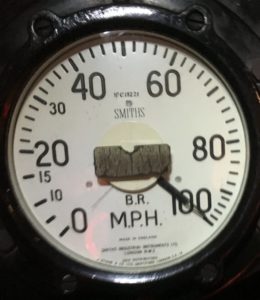Only recently I ran across something almost inexplicable in the world as we commonly understand it. At first it was simply a delightful story about a remarkable machine. Later, however, I found something quite profound about it.
The story concerns what is prosaically referred to as ‘steam preservation’. It seems that in the UK there are people who enjoy preserving the country’s history of steam power. Now, people have all kinds of interests. No doubt there are some who while away the hours collecting porcelain teacups. Harmless enough. But not too exciting.
Well, bear with me.
The serendipity was to stumble upon a YouTube recording of a short BBC documentary from 2017, which covered an attempt to prove that a certain steam locomotive could run safely as fast as 100mph on a commercial rail line. This locomotive is called Tornado, or 60163 Tornado to give it its full name.
The documentary is well done, interesting and informative. I recommend it. Tornado is the centerpiece, of course, and I found there is quite a bit of information about it, out there on the web. Including a couple of surprises.
Now, steam power is pretty stone-age stuff, and I can see where it might be hard for many people pay it the least attention. Still, you have to appreciate the sheer scale of the thing.

And you have to appreciate the workmanship.

They actually run this thing on a commercial rail line pulling tourists. And it’s no slouch. Prior to this trial, Tornado was routinely pulling coaches at 75mph. But, in order to stay viable on a commercial line with modern trains running on it as well, they needed approval to raise its legal maximum speed to 90mph. And in order to do that—since this is a one of a kind—they had to demonstrate safe and stable operation at a slightly higher speed, therefore 100mph.
No suspense. Turnado did it.

And you have to hand it to the trust that is responsible for this beast. Looks like a nice bit of restoration, doesn’t it?
It isn’t a restoration.
The A1 Steam Locomotive Trust built it, and completed it in 2008. It not only runs, it makes money.
Second surprise. They built it from scratch. Every part, from the boiler to the bearings to the pistons, was fabricated from scratch. And the people responsible were volunteers.

This is where I find something profound. We can talk glibly about ‘a labor of love’, but these people clearly love what they do. And they don’t care who knows it. The accomplishment itself is unarguable, the sheer beauty indisputable.

Now, maybe it cost a marriage or two. Obsessions do that sometimes. Sorry, but it’s a price we sometimes pay for being endowed with imagination and intelligence. And sometimes it takes the kind of love these ‘preservationists’ across the Atlantic have, to demonstrate where imagination can take us.
But you need that kind of love to do it.

(All photos courtesy of the A1 Steam Locomotive Trust. Visit them at https://www.a1steam.com.)

Excellent and wonderful to hear your sentiments … The power and engineer in Big Steam Locomotives is something to behold! I saw them being constructed in the 1950’s in the UK and it made me decide on engineering as a career! I started in 1965 as an apprentice and spent my entire life in engineering and loved it! For over 40 years I travelled the world working for and training on new Perkins and Caterpillar products. I joined the A1 Project in 1990 and I never cease to be amazed at just what has been achieved! Just look at the groups latest project – the P2 Loco Trust an even bigger more powerful loco …
LikeLike
Thanks for the comment. And congratulations on being part of A1! Must be quite an experience.
LikeLike